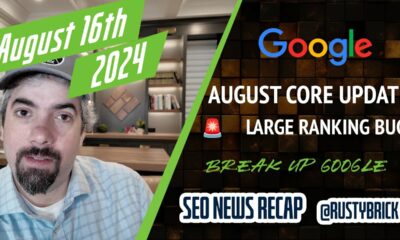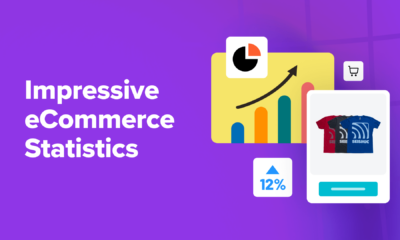MARKETING
How Video Consumption is Changing in 2022 [New Research]
![How Video Consumption is Changing in 2022 [New Research] How Video Consumption is Changing in 2022 [New Research]](https://articles.entireweb.com/wp-content/uploads/2022/08/How-Video-Consumption-is-Changing-in-2022-New-Research.jpgkeepProtocol.jpeg)
In 2022, video is more important to consumers than ever before.
Each day, we stream our favorite shows, watch YouTube videos to learn something new, or follow events, Q&As, and interviews via live video.
While video isn’t going anywhere, it’s always expanding, changing, and evolving to fit consumer preferences and new platforms — and marketers must keep up.
Here, we’ll highlight five research-backed ways video consumption habits are changing and how marketers can respond strategically.
How Video Consumption is Changing in 2022
1. Increasingly, consumers are relying on marketing videos from brands.
In the past, consumers would visit websites, look at online reviews, watch commercials, and maybe watch a few YouTube videos to learn about a product. Now, with video being accessible on every major social media network, they are learning to rely more heavily on this type of content in their research phase.
![How Video Consumption is Changing in 2022 [New Research] Video Consumption](https://articles.entireweb.com/wp-content/uploads/2022/08/How-Video-Consumption-is-Changing-in-2022-New-Research.png)
According to HubSpot Blogs research, 66% of consumers have watched video content (i.e., product demos, reviews, FAQs, unboxings, etc.) to learn about a brand or product.
The trend is clear: in 2022, consumers increasingly expect to see video content from brands. Why? Videos give consumers the opportunity to see how a product or service works in real life, discover any flaws before purchasing the item, and identify perks that they might not learn about in the text-based description.
Further, this content might also appear to be more authentic than a heavily edited product shot, which can boost a consumer’s trust in a brand or offering.
2. Escapism is the name of the game.
In the past, older generations might have turned on their favorite TV sitcom or gone to the movies to escape from the stresses of daily life. While the platforms have changed, the need for relaxing or entertaining content hasn’t.
![How Video Consumption is Changing in 2022 [New Research] Video Consumption 3](https://articles.entireweb.com/wp-content/uploads/2022/08/1660562261_778_How-Video-Consumption-is-Changing-in-2022-New-Research.png)
According to HubSpot Blogs research, consumers say they primarily watch videos to “help me relax and unwind.” Additionally, people cited, “To laugh or be entertained,” as the second most common reason.
Even if you’re creating informative marketing videos, you should consider experimenting with funny anecdotes or adding other entertaining qualities. Interested in adding fun elements to your next marketing video? Get inspired by major brands that effectively used humor in their marketing.
3. Consumers lean into their passions.
Aside from looking for escapism, YouTube viewers are motivated to watch content that teaches them new things, especially when related to their passions, interests, hobbies, or social causes. In fact, according to HubSpot Blogs research, 13% of consumers watch videos to “explore an interest or passion,” while 11% want to “learn something new.”
Odds are your product relates to someone’s interests, hobbies, passions, or career. This is the type of person you’ll want to watch and enjoy your videos.
Creating a buyer persona and target audience around this type of person will help you identify video topics that they’ll value, benefit from, and remember..
4. Production quality is becoming more important.
36% of consumers feel production value is “somewhat important,” while 28% feel it’s “very important.” But fear not — this doesn’t mean you need to rent a high-priced studio or enlist A-list celebs.
![How Video Consumption is Changing in 2022 [New Research] Video Consumption 7](https://articles.entireweb.com/wp-content/uploads/2022/08/1660562261_964_How-Video-Consumption-is-Changing-in-2022-New-Research.png)
Instead, there are plenty of ways to produce an affordable video with solid quality from any home or workspace. And remember, oftentimes the success of a video relies on the value it provides. In other words, fancy lighting alone won’t cut it.
Additionally, video software like Vidyard, Bonjoro, and TwentyThree make it easy to record and send short video messages – like pitches, welcome videos, and more — to customers without needing a Hollywood budget.
5. Consumers prefer shorter videos.
Thanks to the rise of TikTok — and the wave of short-form content that followed — consumers are seeking quick, snappy videos. Specifically, videos under three minutes fall into a sweet spot.
![How Video Consumption is Changing in 2022 [New Research] optimal marketing video length according to HubSpot research-1](https://articles.entireweb.com/wp-content/uploads/2022/08/1660562262_819_How-Video-Consumption-is-Changing-in-2022-New-Research.png)
If you’re new to video, starting with short-form videos can help you get your feet wet — and tell you what resonates with your audience.
You also need to set the right pace for your video content. Before you put a marketing video online, re-watch it from the point-of-view of a somewhat busy consumer. Then, ask yourself, “Does this video pull viewers into the action quickly and keep their attention?”
If you’re worried that parts of your video seem dull, you might want to shorten it. But, if your team thinks it’s entertaining or informative the entire time, you can experiment with publishing your longer-form video and learning from its results.
Navigating Video in 2022
With each new generation, the video world will continue to evolve.
However, at this point, the video landscape is changing in favor of marketers. Not only do consumers prefer to learn about brands via video content, but they use it as a necessary tool in the information-gathering phase of their buyer’s journey.
Additionally, the vast majority of video consumers now strive to learn something new about an interest or hobby, rather than just using video to entertain themselves. This means marketers can harness educational videos in their strategy and offer consumers content that relates to their niche, while also marketing a brand or product.
Back to You
Video isn’t going anywhere, but it is always expanding, changing, and evolving to fit new consumer needs and new platforms.
As this content continues to evolve with each new generation, marketers should continue researching video consumers’ interests, hobbies, and behaviors.

![How Video Consumption is Changing in 2022 [New Research] Discover videos, templates, tips, and other resources dedicated to helping you launch an effective video marketing strategy.](https://articles.entireweb.com/wp-content/uploads/2022/01/1643217248_149_What-Video-Marketers-Should-Know-in-2022-According-to-Wyzowl.png)
















You must be logged in to post a comment Login